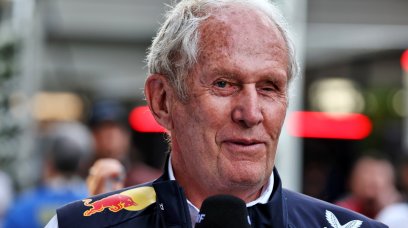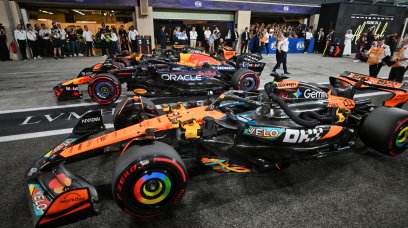The FIA had a busy afternoon in Melbourne during the 2023 Australian Grand Prix. A record three red flags were waved and only 12 drivers made it to the finish line, as Albert Park turned into a battleground. Alex Albon was the catalyst when he lost control of his Williams car and ended up in the wall at Turn 7. The safety car was initially deployed to the amount of debris on track, but the FIA decided to wave the red flag as a recovery vehicle made its way onto the track. Was it necessary? That was the question on the mind of George Russell, who dropped back to P7 after pitting during the Safety Car. But when the red flag was waved it confined him to that position, as other drivers were able to change tyres while in the pit lane without losing positions. "Pretty disappointed initially with the decision to red flag the race," said Russell. "No words for that. Obviously, we had a similar situation in Saudi Arabia with the safety car coming out in an unnecessary circumstance."
F1 journalist Deckers: embarrassing red flag
RacingNews365 F1 journalist on the ground Aaron Deckers gauged the opinions of Formula One drivers, who were actually almost all unanimous: not a good decision by the FIA. "If you look back at the situation, all the drivers agreed: that was definitely not a red flag." "That's painful," Deckers continued. "Because in Saudi Arabia earlier we saw a safety car that shouldn't have been there. There are a hundred cameras on the track there. They should have seen that. This time it wasn't a red flag at all either." "It was simple to clean up, without a red flag, just with a slightly longer safety car situation. That moment was very painful for Russell and Sainz, who otherwise could have been a lot further forward, although of course it made no difference to the Mercedes driver in the end."
Another red flag!
After a standing restart the race resumed and Max Verstappen managed to take the lead of the race away from Lewis Hamilton. It looked like the leaders were managing the pace, as Hamilton responded to the speed shown by Fernando Alonso. Then the Haas of Kevin Magnussen suffered a tyre failure on the exit of Turn 2, causing debris to be strewn across the circuit and some into the spectator areas. A second red flag was chosen a few laps later, because in the eyes of the FIA the safety car turned out not to be enough to clear the track - or at least not in time before the race would be over. After all, there were only about five laps to go when Magnussen hit the wall.
Deckers: "A choice had to be made."
Where there was much doubt about the first red flag, the FIA seems to have made a more logical choice with the second situation, Deckers reasoned. "There was a lot of discussion about the first situation, but less about the end. They decided to wave the red flag. They were in a tough spot, but the red flag situation after Magnussen's crash is not much of a discussion in the paddock." "I thought it was pretty logical. It is a choice that is made. Either finish behind the safety car, or throw in the red flag. The latter option was chosen, but then it became chaos. That was because of the low temperatures in Melbourne. On this circuit, with this asphalt, the drivers suffer a lot from that." "At the restart you saw a lot of drivers make mistakes, mistakes they don't normally make. Sainz was furious and there is something to be said for that. He really didn't make mistakes as thick as Sargeant, for example. Alonso also acquitted him, so that was a debatable penalty. The red flag situation itself, in itself, was not really a debatable situation."
Another restart!
After the second red flag, a third start sequence took place. With two laps to go, the field was let loose, but by now we all know how that ended: total chaos. Carlos Sainz pulled off an ambitious move on Fernando Alonso and tipped the Aston Martin driver into a spin and out of the podium points, which later earned the Ferrari driver a five-second time penalty and put him last in the order. Pierre Gasly committeed the cardinal sin of taking out his teammate Esteban Ocon, in a crash that nearly resulted in a race ban for the Frenchman. Elsewhere Logan Sargeant hit Nyck de Vries into the lap, although this did not get investigated by the stewards. Should the FIA have chosen not to do a third restart and simply flagged the race off after 55 of 58 laps? Some drivers think so. Verstappen was one of them. "These red flags. The first one maybe you could have done, but that second one I don't understand. A (virtual) safety car would have been enough there. As drivers, we were confused. Why did we need a red flag? It was a mess."
How could the chaos happen?
Why did things go so wrong at that last start? Verstappen believes the officials created this scenario. "That's what you create when you send a safety car out driving so slowly. You get no temperature in your tyres. Then the lights go out in turn six, but the safety car then keeps driving very slowly, so then you can't accelerate to warm up your tyres. "Then when you get back on the starting grid, your tyres are twenty degrees colder than normal. Then you already have very little grip. Just chaos. "I don't understand why you wave the red flags anyway, because everything that had happened was fixable with a crane. By those red flags you create so much chaos." Another reason given included Sergio Perez. He pointed to the low sun, due to the late hour in Melbourne. It was almost evening at the time of the last restart. "I have seen many crazy races and that in itself was fine, but we need to start the race here earlier," said the Mexican. "I didn't feel safe at the end of the race, so we need to we need to work on that. The sun is right in our faces. We didn't see anything at the restart.
Deckers: Discussion will always remain
Deckers again earlier on the tire temperatures, but he said the red flag in itself was not illogical. "That red flag situation was not very strange in my eyes, that that restart took place. After that you get all the chaos: how are you going to solve it, how do we determine the result now?" "Sainz was the big loser of the day, obviously. That was painful to see, to see him go down like that. Definitely the big loser. Both Alpines too, but they crashed themselves." Should they have just taken the result after the final red flag after all that chaos? With a Hulkenberg on P4, for example? "Everyone will never completely agree in this discussion. There are too many losers and winners for that. I think the FIA has solved it in the best possible way. In situations like this, you can never get it right. You always will," he concluded.
Most read






